How the CCP corrupted western science
Ince reputable foreign scientific institutions collaborated with and were co-opted by China during the search for SARS origin.
On March 19th, 2003 Hu Jintao officially ascended to the Presidency of the People’s Republic of China, succeeding Jiang Zemin. Soon afterwards, he called an extraordinary meeting of the politburo to reconsider the response to SARS. This resulted in a major policy shift. The new leadership acknowledged that cases had been previously under-reported, that there had been a deliberate cover-up of the situation, and that efforts to control the spread had been lax. Henceforth China would begin an aggressive public health campaign to eradicate SARS including strict quarantines and lockdowns, cast as a patriotic struggle.
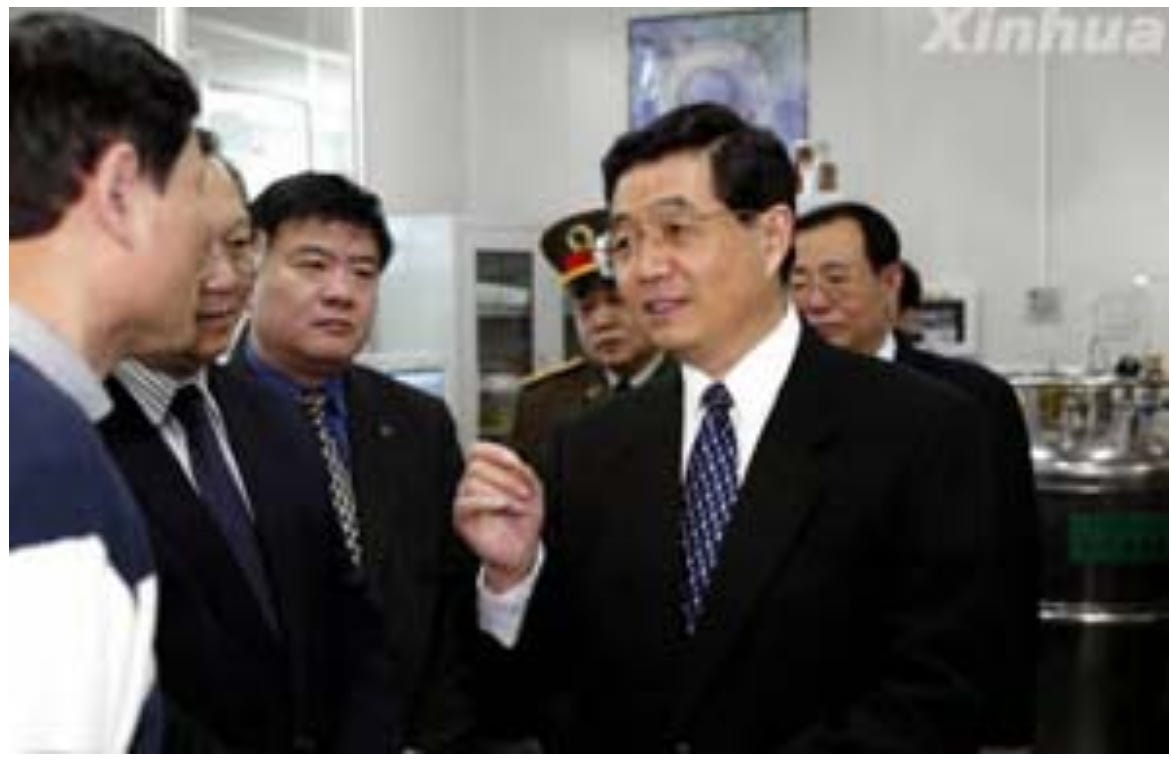
Civil-Military Civets
The day of the politburo meeting, the PLA’s Academy of Military Medical Sciences and CAS Beijing Genomics Institute uploaded to GenBank the sequence of a virus they claimed was isolated from a SARS patient directly connected to one of the index cases in Guangdong. The sequence had a unique genetic feature - an additional 29-nucleotides. In a paper announcing the discovery, they speculated that this virus was close to an original variant that had been transmitted from an unknown animal host. They claimed the 29-nucleotide insert contained a shorter sequence that matched one from the human genome. They speculated that this had hindered replication in humans, and once deleted the virus was better adapted for human spread.
If true, this would represent an astonishing evolutionary lucky break -for the virus. It is similar to the way, SARS-CoV-2 purportedly gained a 12-nucleotide insertion creating a furin cleavage site - immediately before entering the human population. Insertions and deletions happen relatively infrequently in nature. For them to occur at such advantageous sites - within just one or two human transmissions - is remarkable.
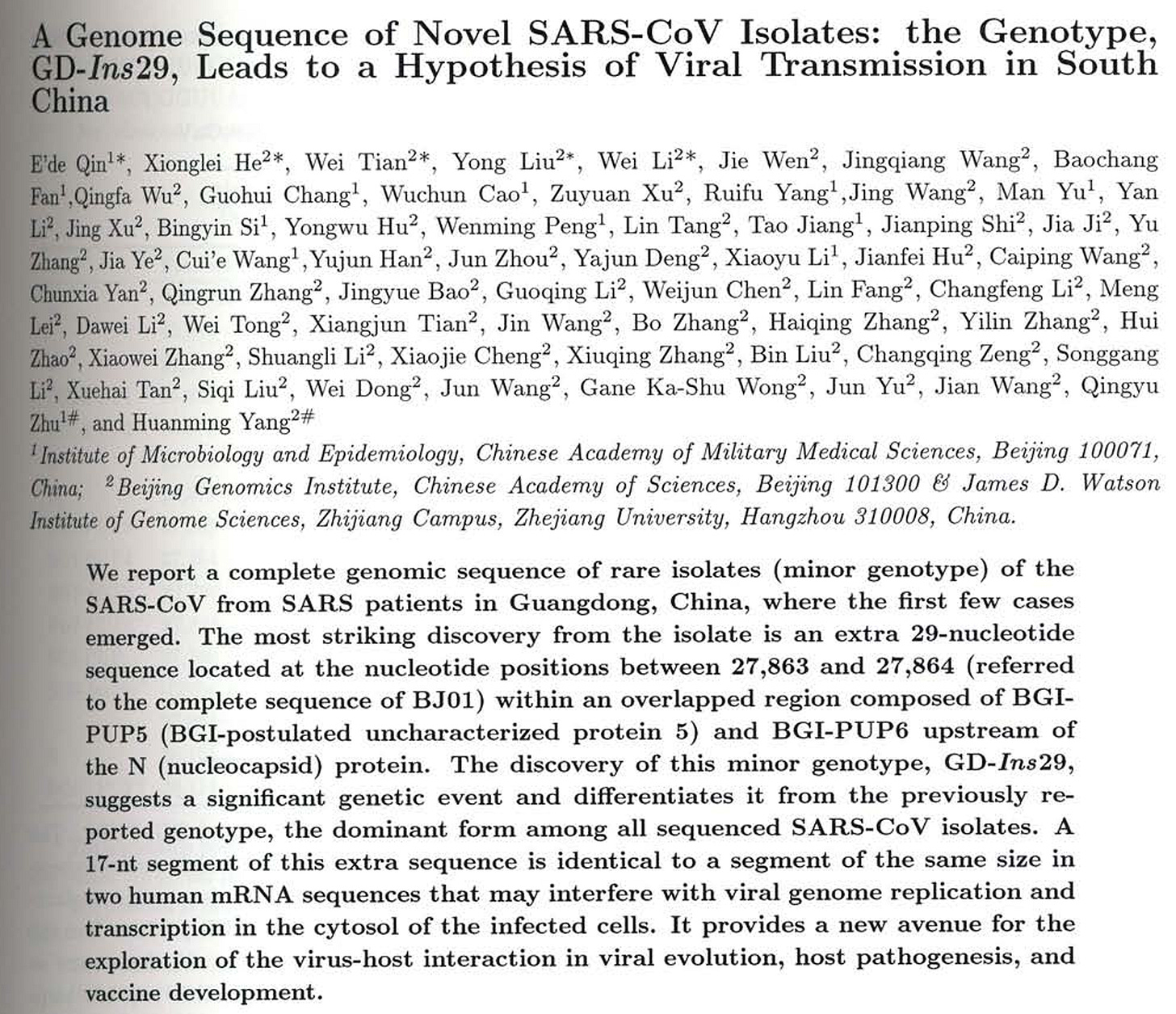
They didn’t have to wait long to find a matching genetic signature in animals. Two HKU scientists Yi Guan and Bojian Zheng were invited to Guangdong to help local authorities in the search for an animal host. Working with Shenzhen CDC they sampled live animals that were being sold for food in markets. On May 23rd, 2003 they announced they had sequenced genomes of a virus very similar to SARS - but which had the extra 29 nucleotides. Positive samples were taken from 6 civets and a raccoon dog.
The civet news was announced by WHO and widely reported internationally. It quickly cemented in the minds of most non-experts that SARS came from civets, and that an artificial origin had already been ruled out. US politicians and commentators showed little inclination to question it. Within a week Goldman Sachs’ CEO (and later Treasury Secretary) Hank Paulson was in Beijing praising China’s leaders and touting for business. Participants in a Congressional roundtable recommended the administration offer China more assistance in bioscience and public health, and refrain from harsh criticism of their earlier secrecy and inaction. That advice was redundant. President George Bush had already offered any assistance needed and praised China’s handling of the crisis in a call to Hu Jintao. Bush was grateful for Beijing’s help in persuading North Korea to attend nuclear disarmament talks. It was an unconducive atmosphere for accusations of terrorism to emerge.

But for scientists, the case was far from closed. Another group from China Agricultural University in Beijing sampled far more widely - 76 farmed and wild civets, 54 other wild animal species, and 11 farmed species. Finding no trace of SARS, they challenged the HKU group’s claim. Their results were not so widely reported.
It’s important to stress that at no point was there an enquiry into the possibility of terrorism (or any sort of artificial origin). It’s unlikely precautions were taken to ensure that samples couldn’t have been deliberately contaminated with viral RNA, or sequence data fabricated. It’s simply not the way academic scientists are used to working. Unfortunately, there’s no practical way to verify sequence data, and no way for independent scientists to reproduce results. To do so might require being at the same location, sampling the same specimen, at the same time. When sampling the same bat colony a few weeks apart, scientists sometimes report entirely different results - perhaps finding nothing at all, where others claimed to have made important discoveries. But “absence of evidence is not evidence of absence”. Scientists are reluctant to cast doubt on a colleague’s work or integrity without solid evidence. On the other hand, tens of millions of people recently died of a SARS-like coronavirus, and our understanding of its origin is based on unverifiable data from Chinese state and military institutions. Is this trust-based system fit for the purpose of attributing potential acts of bioterrorism or biowarfare?
HKU’s Department of Microbiology was closely involved in the SARS investigation and was afterwards subsumed by the PRC. It was designated China’s State Key Laboratory for Emerging Infectious Disease. This came with extra funding from the PRC government, and collaborations with mainland institutions including WIV (designated the State Key Lab of Virology), and AMMS (State Key Lab of Pathogens and Biosecurity). During SARS-CoV-2, this HKU group collaborated on pangolin coronaviruses with AMMS.
Institut Pasteur assists the PLA - then loses all its samples
The civet claims were controversial even among scientists with a natural origin leaning. There was no evidence that civets were a reservoir species - that would require showing SARS was circulating in farms. It was instead possible that they were an intermediate host infected by an as yet unknown reservoir species, or even that humans had infected civets, rather than vice versa. The WHO managed to win agreement from Beijing that foreign teams could participate in an expanded origin search, but the scope of the investigation had already been restricted to natural causes.
Institut Pasteur was one foreign institution invited. Their scientists worked alongside the AMMS in Beijing. One joint paper looked at the molecular evolution of the virus in the Beijing outbreak, noting that the same series of mutations had occurred in Beijing as in Guangdong and Hong Kong. The evolution occurred independently (convergently) in isolation from the outbreak elsewhere. This allowed them to speculate the mutations were an artifact of the process of adaptation to humans.
This study was based on just 45 samples from 29 patients. Institut Pasteur had somehow accumulated thousands of samples which they had sent to their Paris lab. In 2004 sequencing so many genomes was impractical, so there are only around 200 SARS genome sequences in total. But with the new technology of Next Generation Sequencing (NGS) being introduced, it would soon become possible to analyze them all, to more completely understand the epidemiology and evolution of SARS.
In April 2014 Pasteur announced they had “lost” 2349 SARS samples stored in their Paris lab. In a bizarre incident, a freezer used to store the samples securely had broken down. The samples were then transferred to a temporary freezer in a less secure area, accessible to several different research groups. Vials of SARS first went missing a few at a time, before the remainder disappeared all at once - including the freezer. The case prompted public anxiety and a judicial enquiry but was never solved.
Recently, scientists from Institut Pasteur sequenced a polio isolate they had stored for over 60 years. To their surprise it matched a sequence WIV claims to have isolated from a child in 2014. Might this have come from the same freezer?
In a recent echo of this incident, hundreds of samples of dangerous bat viruses such as lyssavirus and hantavirus went missing from a Queensland government facility in 2021. Just as in the Pasteur incident, it occurred after a freezer broke down in a secure storage area and the samples were transferred elsewhere in the complex where control of access and documentation was less rigorous. The breach wasn’t reported for over two years. A small enquiry, led by a former Supreme Court judge, is ongoing.
Institut Pasteur also became deeply involved with WIV in this period. The Wuhan P4 lab was conceived as a joint Sino-French project. It was originally planned for Shanghai, but the site was thought too populous. The intention was that Institut Pasteur would have a permanent presence at the lab, for that purpose Institut Pasteur Shanghai was founded as a joint venture with WIV’s parent organization CAS.
More about Institut Pasteur and other French involvement here.
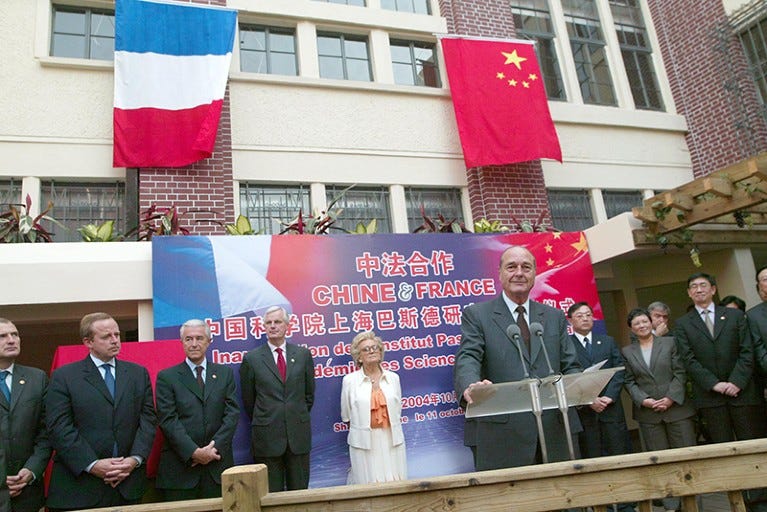
The SARS epidemic was effectively over by June 2003, but in December 2003 and January 2004 four new cases were reported in Guangzhou. Civets were again sampled and a nearly identical strain was claimed to have been found almost immediately. This led to the slaughter of thousands of civets, in markets and farms. A subsequent paper listing several Institut Pasteur authors, purported to strengthen the link to civets. Both the human and civet strains have the additional 29 nucleotides, and the authors propose this led to its relatively mild symptoms. Lurking among the long list of authors are several AMMS officers, all of whom are concealing their military affiliations.
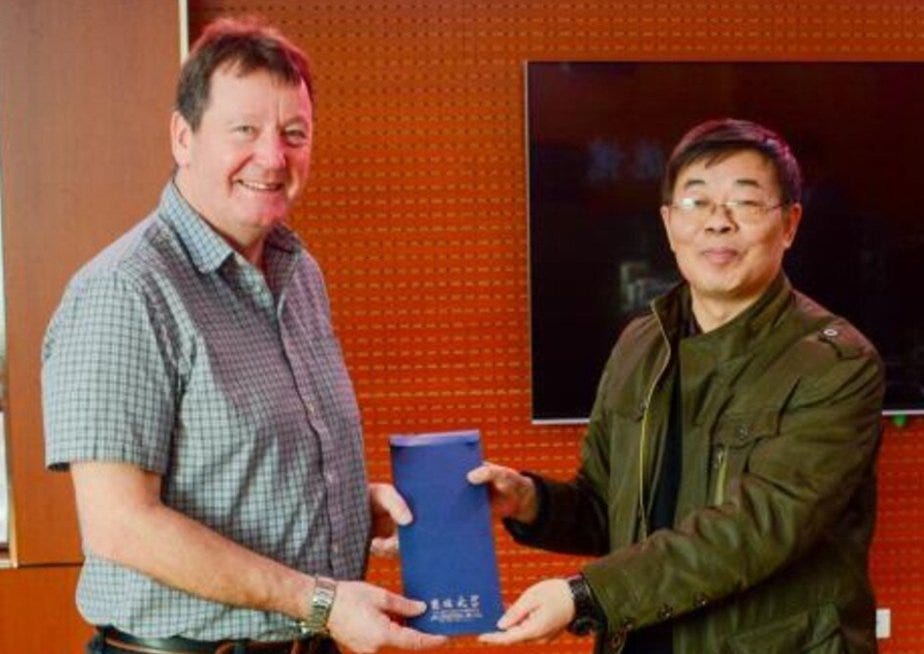
After these events, SARS disappeared from the world (aside from labs) and hasn’t been reported since - in civets or humans (aside from lab leaks). This is unique in the history of infectious disease. The only precedent for the complete eradication of a human pathogen is smallpox, which required a 20-year intensive global campaign - armed with an effective vaccine.
But most international scientists still didn’t accept that civets were the culprit, and the origin search continued.
Batman arrives on the scene
Another collaboration was formed between Australia’s CSIRO, US-based EcoHealth Alliance and the Wuhan Institute of Virology (WIV). WIV’s Zhengli Shi is sometimes referred to as “batwoman”, but before SARS she studied viruses of marine crustaceans. Linfa Wang, a former Chinese national who led a team based at CSIRO’s BSL-4 lab in Geelong, was already a bat virus expert - as were his team. Was this group assembled because bats were already suspected? If someone had a hunch, it proved correct. It didn’t take long before this collaboration found and sequenced the first bat SARS related coronavirus (Rp3) which was sampled in Guanxi province. The HKU group announced their discovery of a similar virus (HKU3) in Hong Kong, at almost the same time.
While there is no doubt Rp3 and HKU3 are related to SARS and very similar through much of the genome, there is a catch. The important spike gene is different. In particular the Receptor Binding Domain (the part of the spike that binds to the host cell and so determines which species, organs and tissues can be infected) is shorter than that of SARS, and structurally different. As a result, Rp3, HKU3 and other bat viruses subsequently discovered in Southern China are unable to bind ACE2, the cellular receptor of SARS.
A few years later, a group led by well-known German virologist Christian Drosten discovered a virus in bats sampled in Bulgaria (BM48-31). This virus is quite different to SARS through most of the genome, yet surprisingly it had an RBD that was closer to SARS than any virus yet discovered in China. More recently, other viruses have been discovered in the UK, Russia, Uganda and Kenya that also have an RBD closer to SARS. SARS appears to be constructed of a Chinese lineage bat virus, with the RBD replaced with something like the RBD of an Afro-European lineage bat virus. How is this possible when tiny horseshoe bats are capable of only short migrations of perhaps a few kilometers? Although distantly related, the two viral lineages likely evolved in isolation from each other for centuries or longer.
Assuming somehow a rendezvous of the two lineages occurred, there are two ways genetic information might be exchanged between them: in a lab by editing the genomes to make a chimera, or in nature by an evolutionary process called recombination. The mechanism of coronavirus recombination wasn’t well-understood at the time, and there are still many unresolved questions. What is broadly agreed is that it can only occur when two viruses infect the same host, and the same host cell. During the replication process, the replication apparatus (RdRp) occasionally pauses. When it resumes it can switch from the RNA strand of one virus to that of another. The resulting virus is a hybrid of the two
But the devil is in the detail, and this is where controversies arise. At what locations in the genome do the crossovers (or breakpoints) from one virus to another occur? Do they occur randomly, or are they determined by structures or motifs (patterns) in the RNA? How frequently? How many times during the course of a replication might the strands be switched - one, two, or several? How similar do the viruses need to be to each other?
In late 2007, the WIV/CSIRO group ran an experiment in which they created chimeric spike proteins consisting of the spike of Rp3 with various lengths of the SARS RBD replacing the corresponding region of Rp3. The goal was to determine a minimal region to make a spike able to bind the human ACE2 receptor. The region they found to be optimal was that between amino acids 310 to 518. Make a mental note of these numbers, there may be a test!
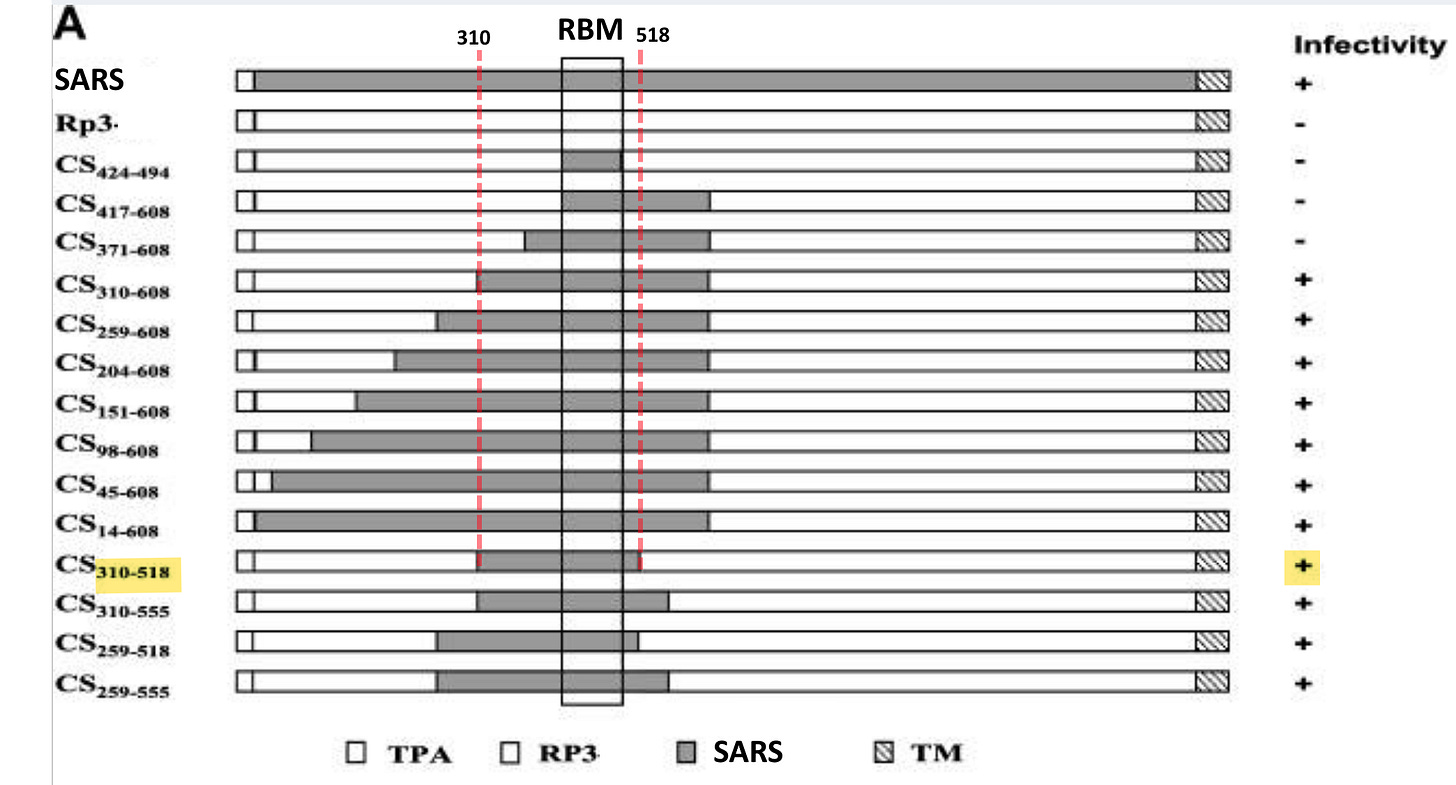
Soon afterwards, a Baric-led UNC/Vanderbilt team went a step further, creating a chimeric live virus consisting of a consensus bat virus (based on HKU3) with the RBD replaced with that of human SARS. They determined this artificial virus was capable of infecting human cells and causing disease in mice. This group elected to use the region of SARS RBD bounded by amino acids 319 to 518. These bounds were chosen based on earlier experiments binding various fragments of SARS RBD to ACE2.
The hypothesis justifying these experiments is that there is the possibility two viruses might infect the same bat. One with a human infectious RBD could recombine with another non-human infectious and creates a novel virus that might be human infectious. This idea should have aroused more scientific debate because it conflicted with a widely accepted understanding of recombination.
Why should crossovers happen precisely at the boundaries of the RBD as estimated by scientists? It was widely accepted that breakpoints occur at effectively random locations. Indeed, this is supported by recent observations of recombinant SARS-CoV-2 variants.
Replacing a finite region such as the RBD requires two crossovers. But it was known from experiment that single crossovers are far more common. Again, this is supported by observations of SAR-CoV-2 recombinants.
Why would an RBD that enables human respiratory transmission have evolved in a bat enteric virus? This question is even more pertinent to SARS-CoV-2 where that transmission is extraordinarily efficient.
There is also quite some diversity in the genomes of various horseshoe bat species. In 2008, it was shown that SARS RBD couldn’t bind the ACE2 of Rhinolophus pearsonii, the host of Rp3. That seemed to rule out that SARS could be formed by a recombination involving Rp3. WIV now claimed they had previously misidentified the host species of Rp3. It had actually been R. sinicus, they declared, whose ACE2 they had recently sequenced and shown could bind SARS. Problem solved, but this would cause further complications. R. sinicus has a range limited to China so how was the recombination with an Afro-European lineage virus possible? This gap in the evolutionary trail was later filled by AMMS Colonel Changchun Tu who claimed to have discovered a SARS-like virus in another species (R. ferrumequinum) with greater range.
CSIRO hosts WIV’s “gain of function” experiments, then loses all its documents
It is not widely known that in 2011 a scientist from the Wuhan Institute of Virology, interned at CSIRO’s BSL-4 lab in Geelong attempted to engineer a live chimeric virus based on Rp3, with the RBD of SARS. This work was never disclosed. I discovered it serendipitously in a response by CSIRO to one of my FOI requests.
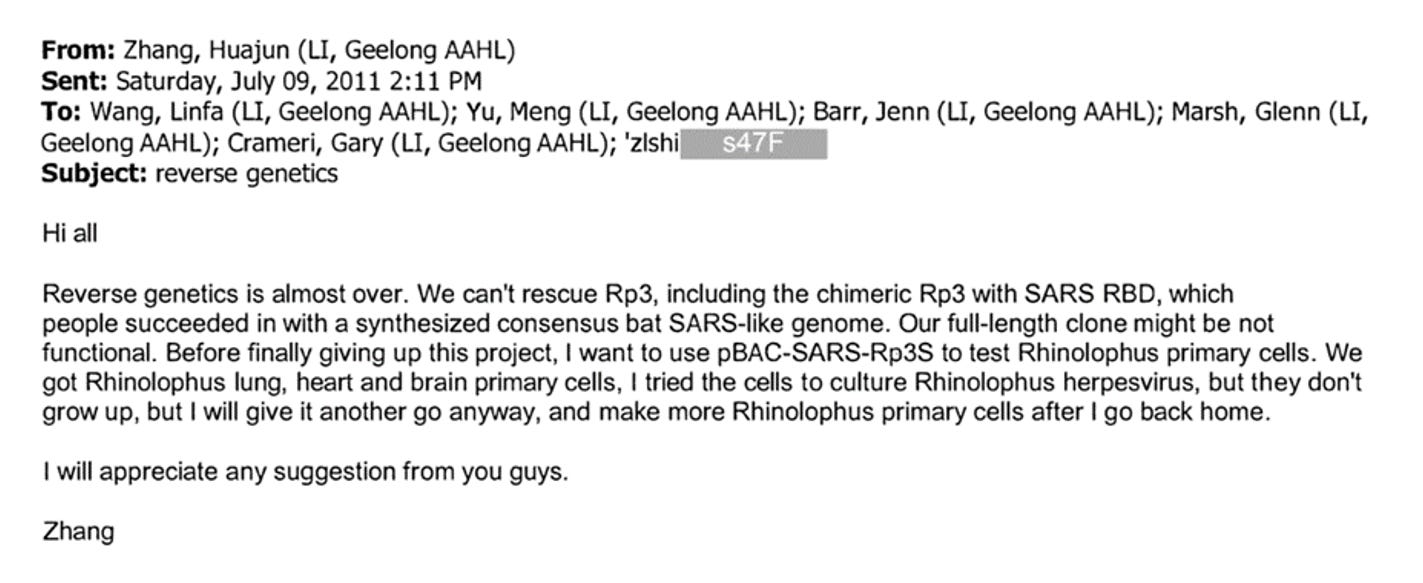
After seven FOI applications to CSIRO, they haven’t been able to provide me a single document from their 14-year collaboration with WIV directly relevant to their work on the origin of SARS. Yet this was the primary focus of their collaboration and resulted in over a dozen papers. They have furnished me correspondence with WIV of a more general nature and some unrelated work e.g. a study on the immune system of fruit bats, book chapters, conference invitations etc. Among hundreds of uninteresting pages, the single interesting snippet (the email above) slipped. Disturbingly, SARS related material wasn’t denied to me on typical privacy/commercial-in-confidence/too-much-work grounds, but because CSIRO claims no such documents exist. Why might this be - and why was I requesting this information?
In 2013, the WIV/CSIRO team announced they had discovered three new bat viruses in a cave in Yunnan. Two of these (WIV1, Rs3367) had an RBD that was very similar to SARS and could bind human ACE2. A third, RsSHC014, had quite a different RBD, but was later shown (by Vineet Menachery and Ralph Baric) to still be capable of human ACE2 binding and causing disease in mice. What’s more, WIV claimed they had cultured WIV1 as live virus from a bat fecal sample. This had never been accomplished before. It was big news in the scientific world, heralded as definitive proof SARS came from bats. It even resulted in some mainstream media coverage for CSIRO (though according to their FOI staff, no-one sent a single email about it).
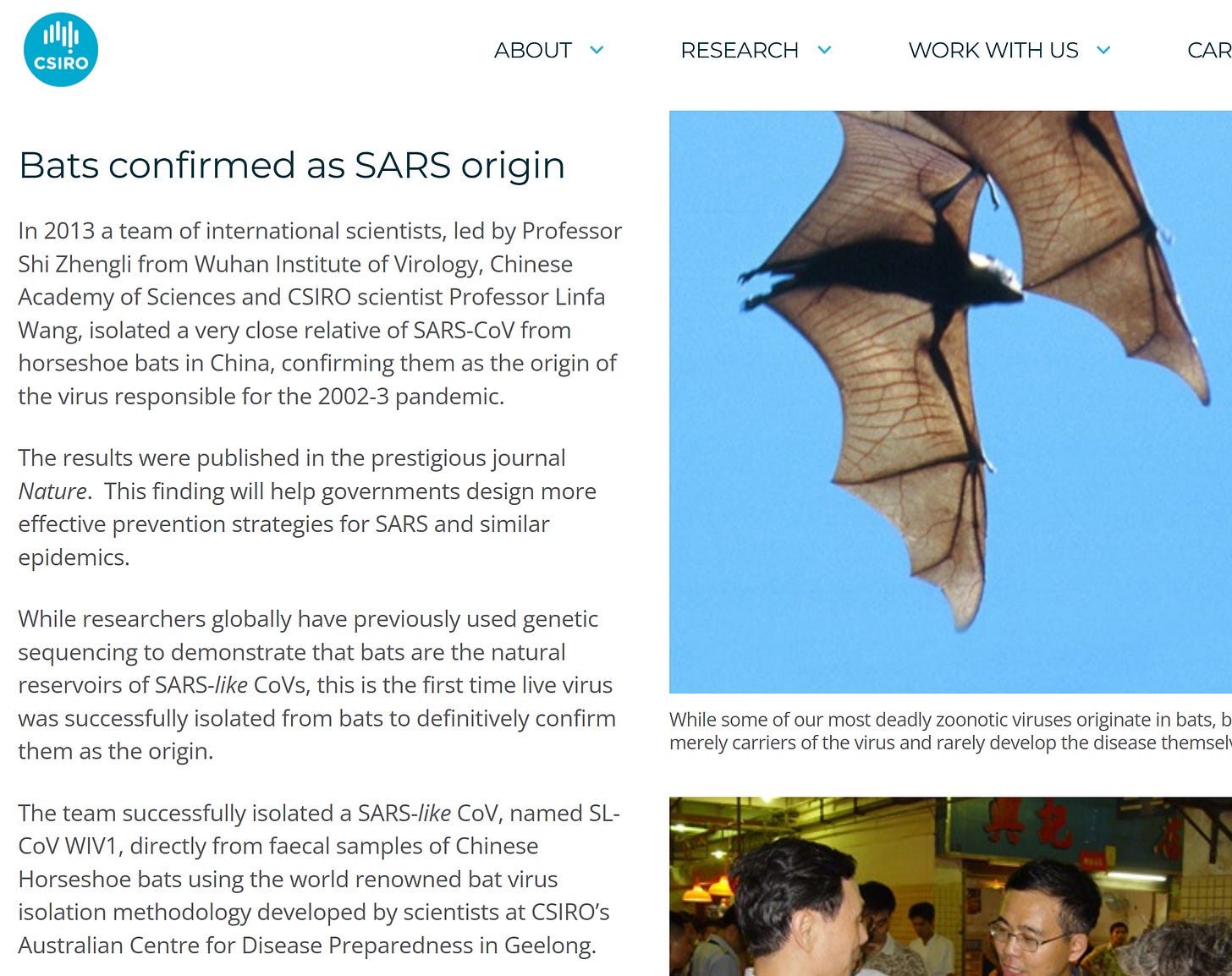
In light of SARS-CoV-2 I re-analyzed these viruses and found that when compared to each other they were almost identical through the genome, with only the RBD materially different - almost as if they were chimeras like the Baric experiment above. There were so few mutations in most of the genome, if there had been a natural recombination, it must have occurred very recently. But most surprisingly, the crossover points are at (almost) the precise locations WIV had previously determined were ideal for making chimeras - at amino acids 306 and 518 (c.f. 310 and 518).

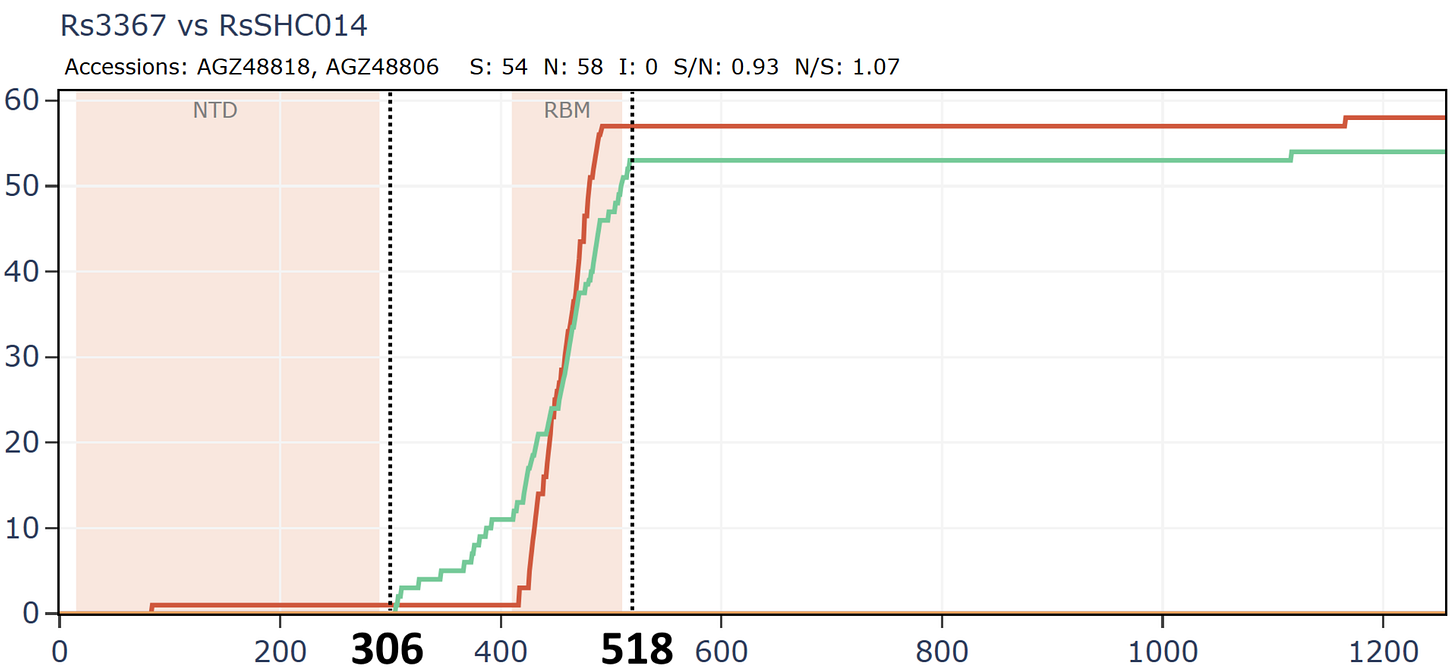
Were scientists just extremely accurate at predicting nature? Was nature imitating science? Or was the claim that these viruses were found in nature fraudulent? They look as if they were made in a lab, and the email above shows that they were trying to make similar chimeras in the lab. Could CSIRO documentation help support or refute their claims?
An intelligent layperson might be tempted to think that perhaps there is something about the structure of the protein that makes these specific locations ideal for a recombination breakpoint. But recombination happens at the RNA level. The replication apparatus knows nothing about protein structure, it simply reads a sequence of nucleotides from the RNA strands and duplicates them.
Some experts argue that it’s a little more complicated. It’s true there are various unproven and sometimes competing theories involving RNA secondary structure, TRSs and other RNA motifs etc. But observational evidence doesn’t support this. The most compelling evidence comes from SARS-CoV-2, which has left us with tens of millions of sequences - a unique opportunity to study recombination. For comparison, there are only around 100 bat sarbecov genomes sequenced - most of which are published by WIV, AMMS and other Chinese state institutions. It is unwise to base general theories on these alone - or to make exceptions from principles that apply broadly to other viral families. For a more thorough discussion of recombination, please see my preprint here - or post a comment below.
There is another extraordinary feature of the WIV/CSIRO viruses. WIV1 and Rs3367 are almost identical through most of the genome (>99.9% in nucleotides), but WIV1 has an entire extra gene inserted - called ORFX. If genuinely natural, both the RBD recombination and ORFX are scientifically remarkable and have profound implications for our understanding of viral evolution.

Conversely, if scientists are wrongly led to believe that a virus can instantly acquire an extra gene, or switch RBDs in nature, this has profound implications for the misattribution of bioweapons. An extra gene could code a protein that e.g. suppresses the immune response, while an RBD switch can instantly confer human infectivity. These claims warrant intense scrutiny and debate - which they did not receive! Bizarrely, while these features are evident from the sequences, neither is discussed in the Nature paper describing their discovery.
In later work published only in Chinese, WIV claims to have discovered a virus Rs4084, that has two variants with different version of ORF8, but is otherwise identical through the genome. This implies an entire gene has been switched through recombination, precisely at its boundaries. This is another dangerous precedent enabling the misattribution of bioweapons - if it comes to be widely accepted.
My conjecture is that WIV’s objective wasn’t to design a new bioweapon agent, but to cover up the unnatural origin of SARS-1, and more chillingly to enable the misattribution of future bioweapons. WIV certainly wasn’t capable of engineering SARS-1 in 2002, and though more proficient in genetic engineering by 2019, I doubt it had the capability of engineering SARS-CoV-2 (which is, in my view, a more sophisticated work than just a bat virus with an FCS insertion). At least, it’s unlikely WIV could engineer SARS-CoV-2 alone - but perhaps in a military-civil fusion collaboration with AMMS.
I had expected that WIV’s long-term collaborators CSIRO would retain some documents and correspondence that could provide clues that could either support or refute their claims. It’s hugely disappointing that they either retain nothing, or are lying to the public about what they have. It isn’t necessary that they accept my theories, their obligation is to store government documents securely and comply with reasonable FOI applications.
In an interesting coincidence, at almost the same time WIV’s viral sequences were published and the Nature paper went to press in November 2013, CSIRO was the target of a data-security incident. This was investigated by Australia’s intelligence service, ASIO, and the Australian Federal Police, and was escalated at diplomatic levels. A CSIRO scientist, a Chinese national, had failed to show up for work one day, or ever again - eventually resurfacing in China. Police interviews with his colleagues and supervisors showed that he didn’t seem competent in his role. What data was stolen - or deleted - was never determined. I suggested to CSIRO executives this incident may be connected, but they were dismissive. Yet they are still unable to explain why they retain no documents.
In 2003, with optimism high that China might open up and reform its political system, there may have been few objections to partnering with WIV, even if wrongly presumed to be a public health investigation. Facilitating WIV’s gain of function research was stretching it, there was no justification for such experiments - the hypothesis had already been proved. Partnering with AMMS - who were known at the time to have offensive bioweapon ambitions - is less justifiable. Depressingly, CSIRO have proven unwilling to re-assess their past collaborations, or re-examine the work they produced. In not furnishing documents they have forsaken democratic standards of transparency and accountability, and a fundamental principle of science: that extraordinary claims can be independently scrutinized - if not entirely reproduced.
In May 2020 the then head of ADCP, Trevor Drew, was interviewed about CSIRO’s engagement with WIV. He blatantly lied that the work was of a general nature relating to bat immune systems, after prompting by the ABC interviewer that perhaps the work had been about the origin of Hendra (from 2:17).
CSIRO has faced criticism for other joint ventures with China e.g. with CETC - a Chinese state-owned defence manufacturer, a cybersecurity JV with Shanghai Jiao Tong University notorious for training hackers, CSHOR - a JV with Qingdao National Marine Laboratory set-up to map the ocean floor around Australia either for addressing climate change - or submarine warfare (depending on who you ask). CSIRO pretends to be a science organization acting in Australia’s interests but apparently has no concern for our national security or democratic values.
The CCP corrupts all and degrades our trust in institutions.
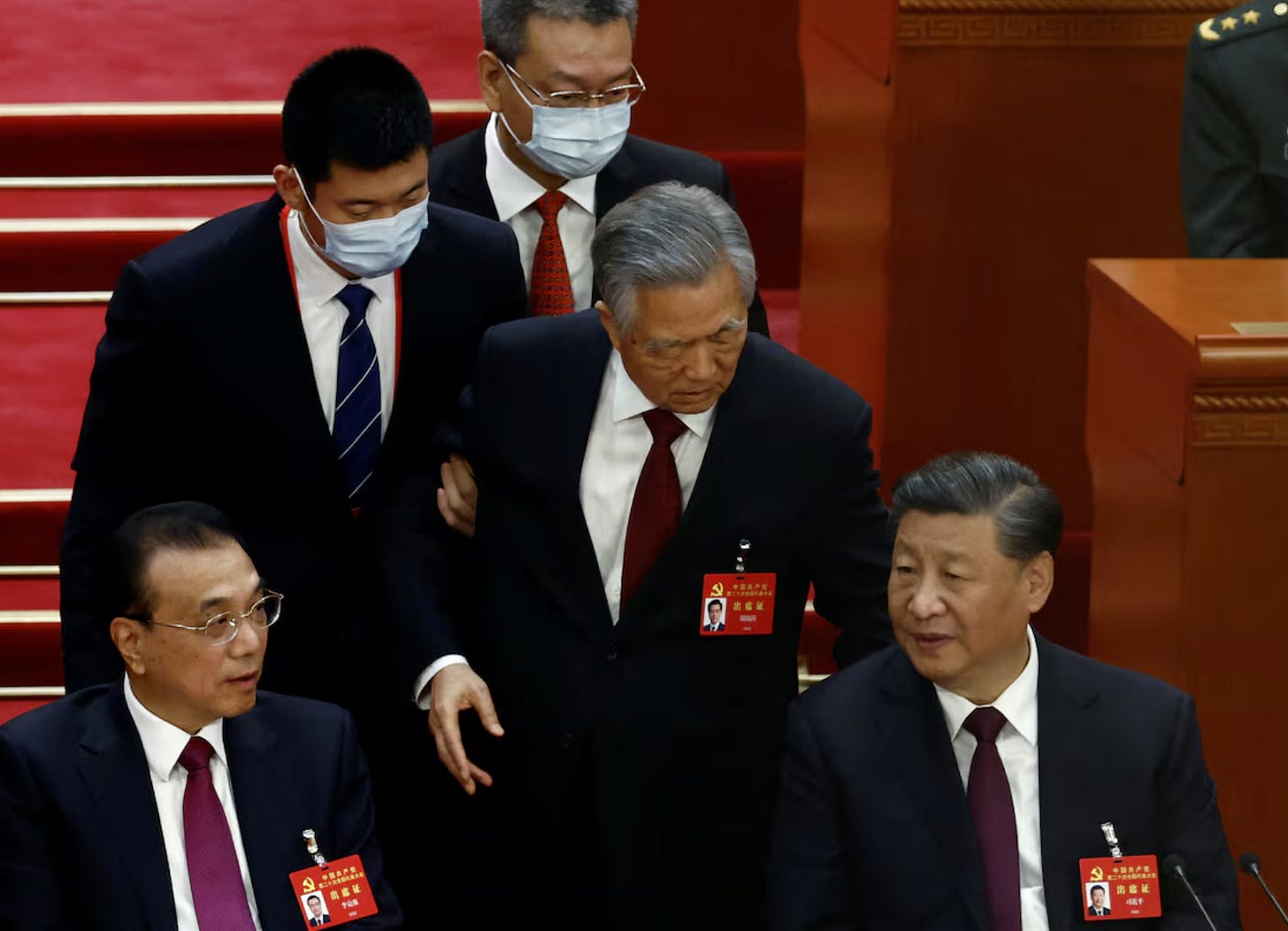

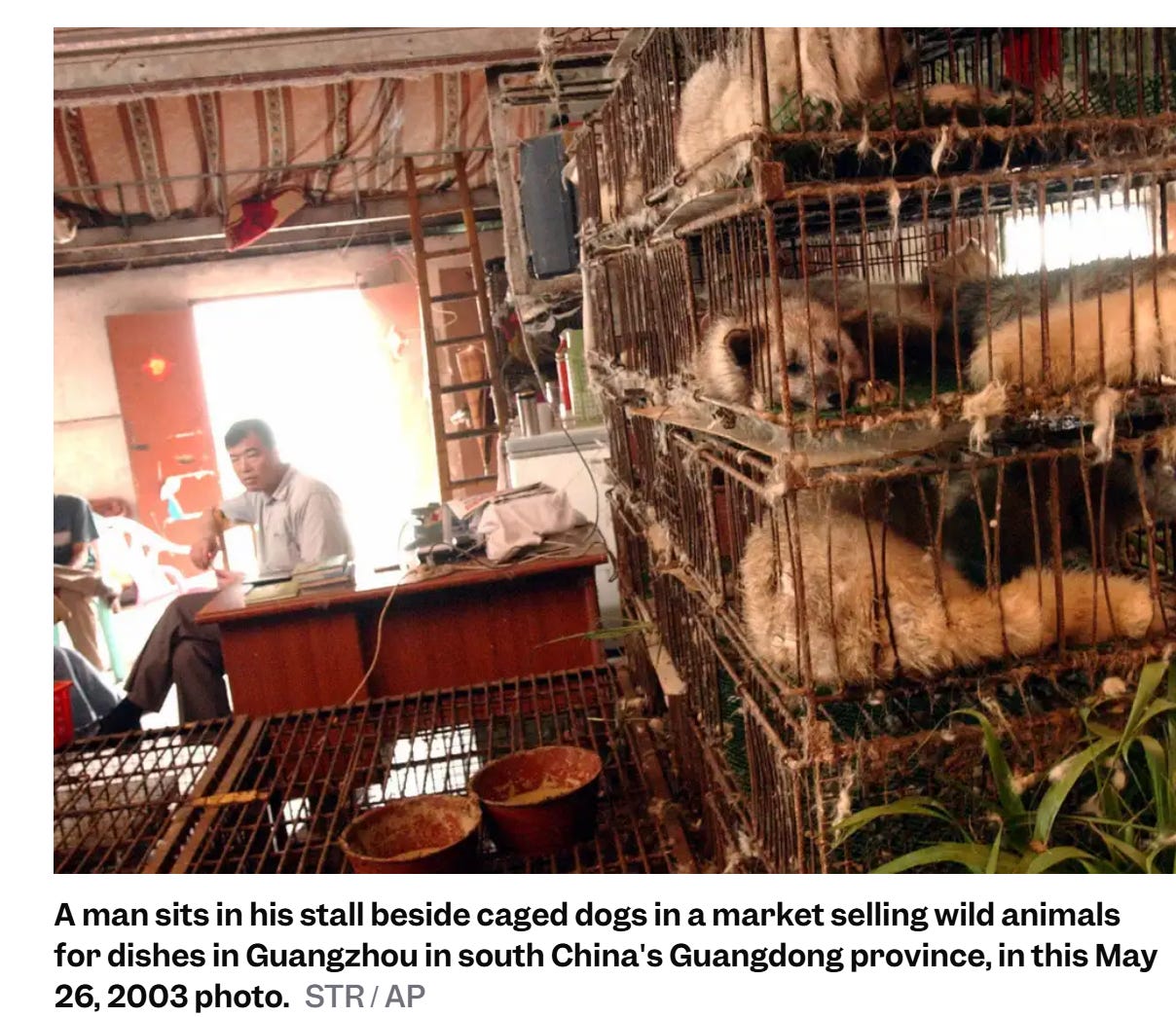
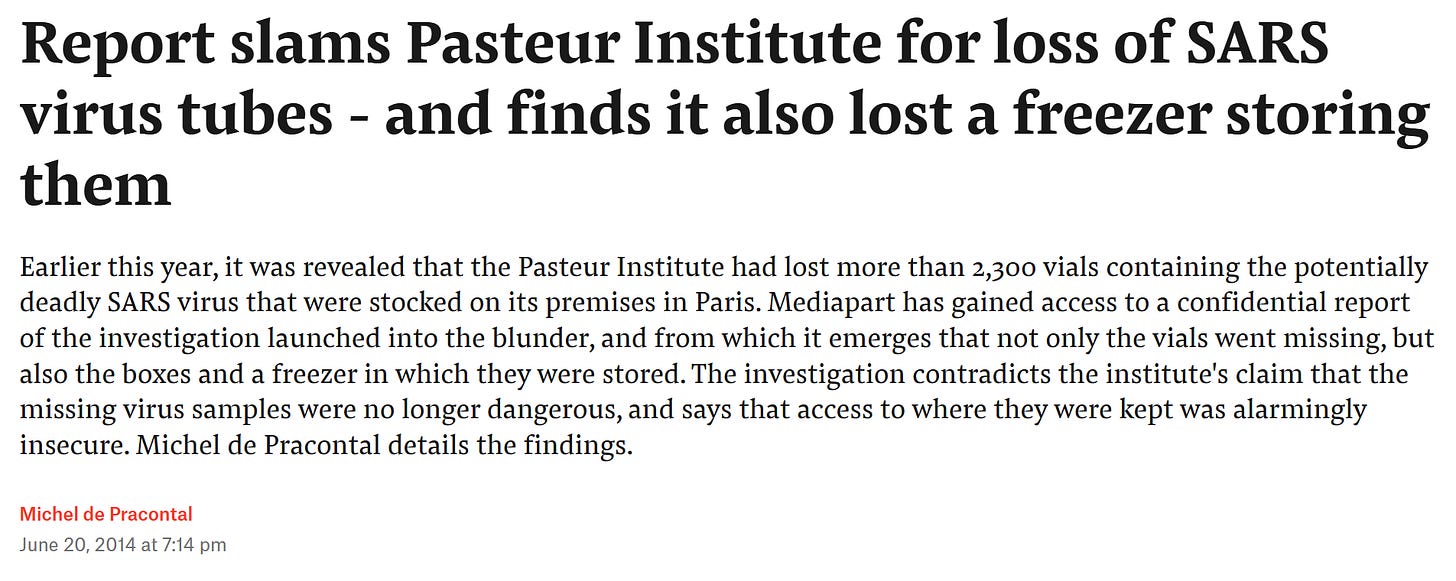

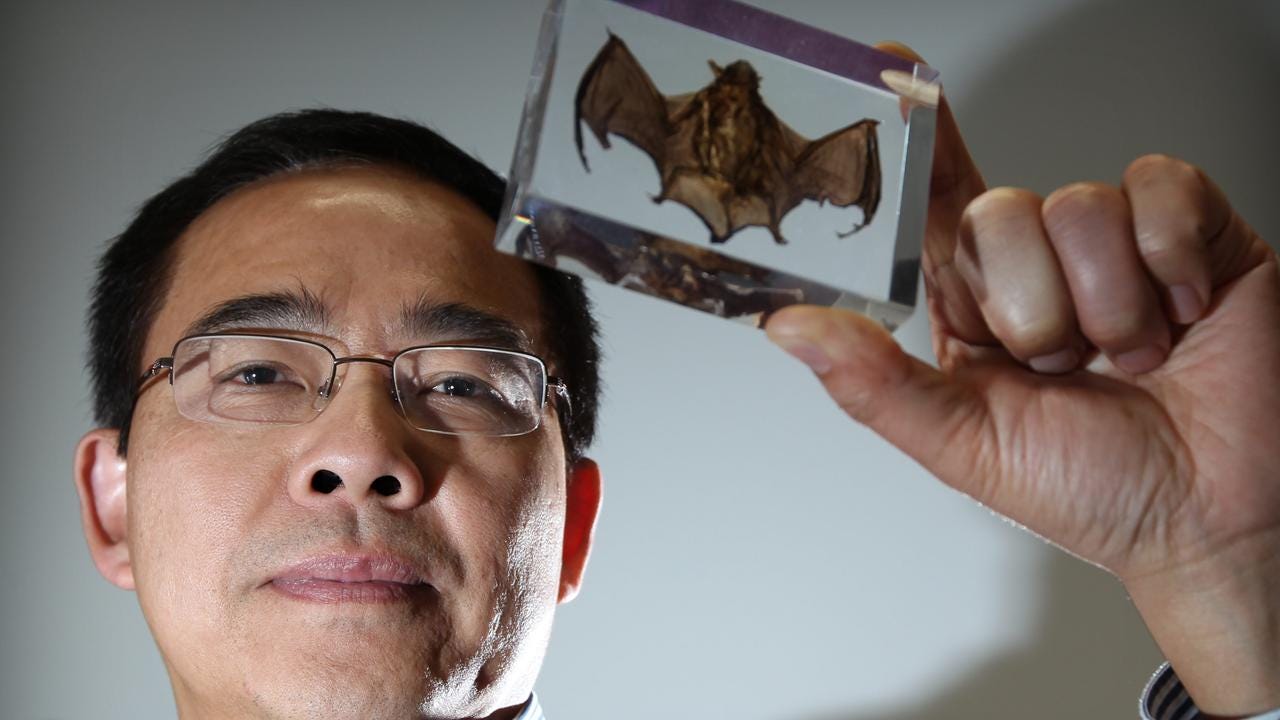
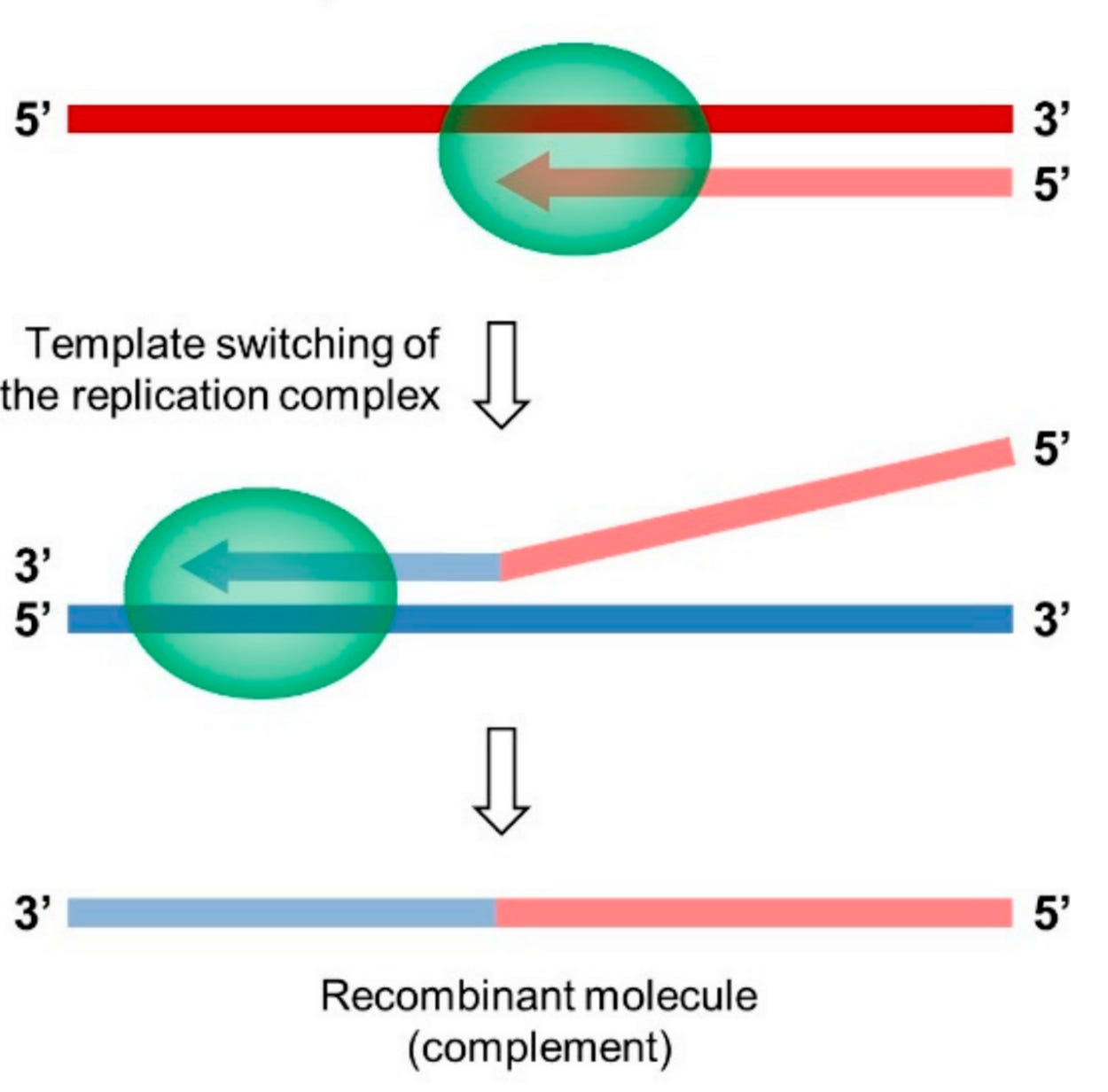



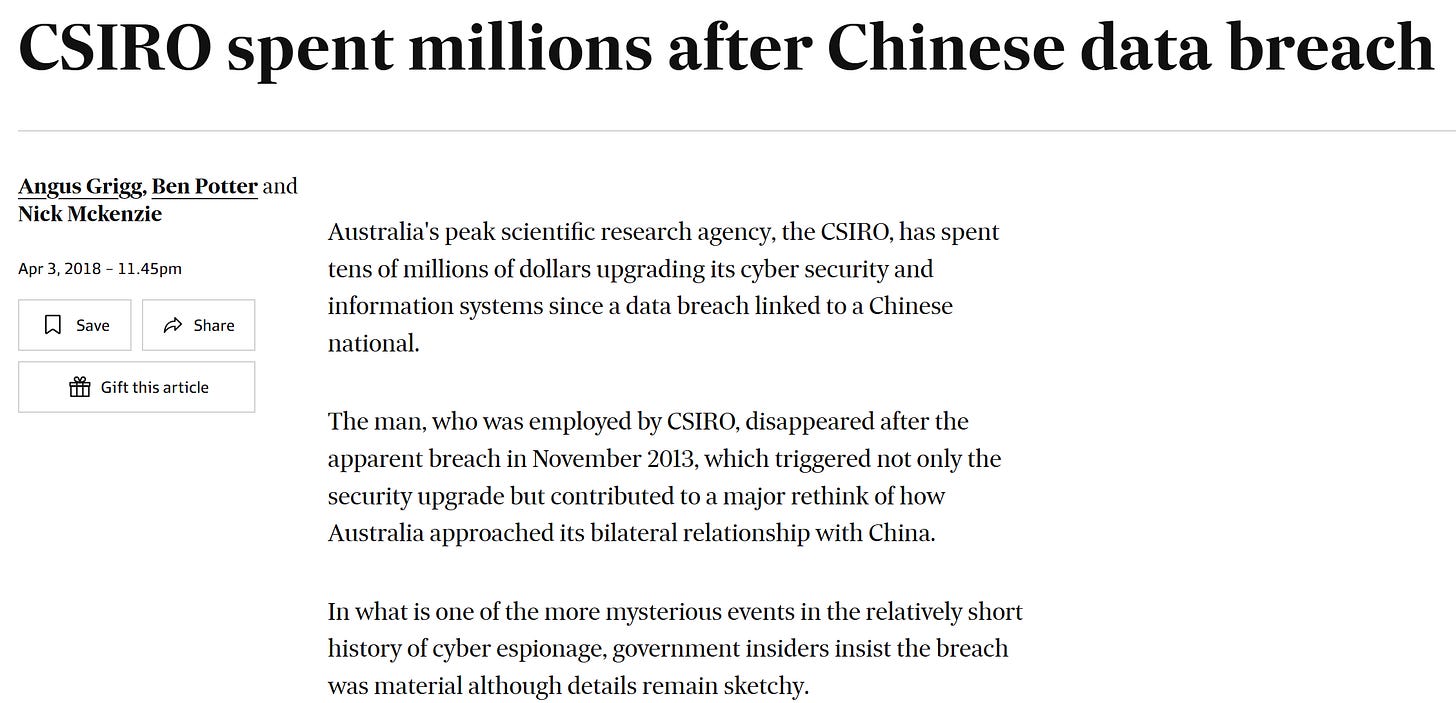
🙏 very interesting, CSIRO sold its soul awhile ago
It's the core. Kill the heart, the body dies... Rockefeller, follow his footsteps..